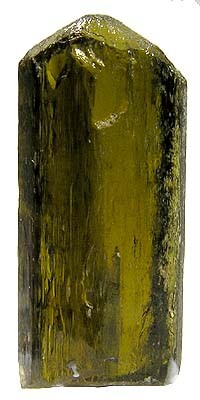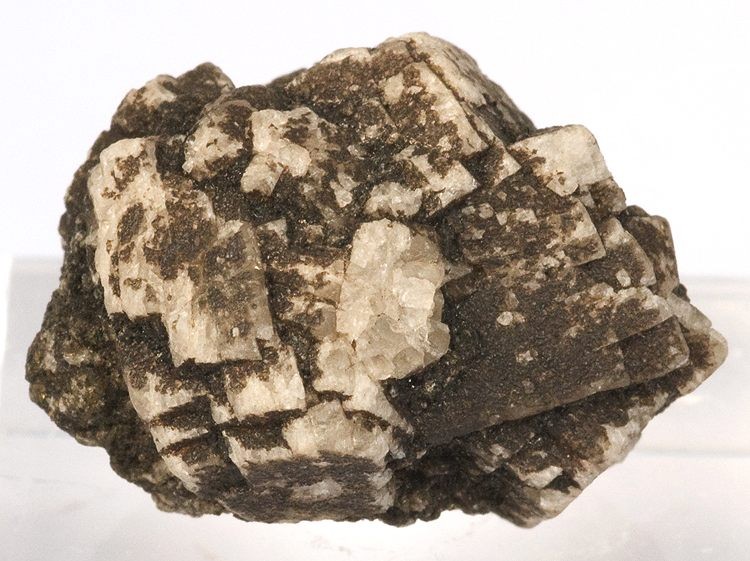|
ALH 81005
Allan Hills A81005 or ALH A81005 (sometimes also named without the "A" in front of the number) was the first lunar meteorite found on Earth. It was found in 1982 in the Allan Hills at the end of the Transantarctic Mountains, during a meteorite gathering expedition (ANSMET). Discovery and naming ALH A81005 was found on 17 January 1982 by John Schutt and Ian Whillans. It is named after the Allan Hills, a mountain chain in Antarctica where many meteorites are gathered by expeditions. The large number of meteorites collected in Antarctica and the lack of geographic terms that could be used for names have led to the adaption of the "Antarctic rules" for meteorite naming. Every meteorite found in Antarctica receives the names of the collection area (Allan Hills) and a number. The number consists of the year the expedition started "81" and a three digit number that is given out consecutively (005). The "A" in front of the number stands for meteorites collected by ANSMET expeditions and ... [...More Info...] [...Related Items...] OR: [Wikipedia] [Google] [Baidu] |
Achondrite
An achondrite is a stony meteorite that does not contain chondrules. It consists of material similar to terrestrial basalts or plutonic rocks and has been differentiated and reprocessed to a lesser or greater degree due to melting and recrystallization on or within meteorite parent bodies. As a result, achondrites have distinct textures and mineralogies indicative of igneous processes. Achondrites account for about 8% of meteorites overall, and the majority (about two-thirds) of them are HED meteorites, possibly originating from the crust of asteroid 4 Vesta. Other types include Martian, Lunar, and several types thought to originate from as-yet unidentified asteroids. These groups have been determined on the basis of e.g. the Fe/ Mn chemical ratio and the 17O/18O oxygen isotope ratios, thought to be characteristic "fingerprints" for each parent body. Classification Achondrites are classified into the following groups:O. Richard Norton. The Cambridge encyclopedia of meteorites. U ... [...More Info...] [...Related Items...] OR: [Wikipedia] [Google] [Baidu] |
Pyroxene
The pyroxenes (commonly abbreviated to ''Px'') are a group of important rock-forming inosilicate minerals found in many igneous and metamorphic rocks. Pyroxenes have the general formula , where X represents calcium (Ca), sodium (Na), iron (Fe II) or magnesium (Mg) and more rarely zinc, manganese or lithium, and Y represents ions of smaller size, such as chromium (Cr), aluminium (Al), magnesium (Mg), cobalt (Co), manganese (Mn), scandium (Sc), titanium Titanium is a chemical element with the symbol Ti and atomic number 22. Found in nature only as an oxide, it can be reduced to produce a lustrous transition metal with a silver color, low density, and high strength, resistant to corrosion in ... (Ti), vanadium (V) or even iron (Fe II) or (Fe III). Although aluminium substitutes extensively for silicon in silicates such as feldspars and amphiboles, the substitution occurs only to a limited extent in most pyroxenes. They share a common structure consisting of single chains of si ... [...More Info...] [...Related Items...] OR: [Wikipedia] [Google] [Baidu] |
University Of Chicago
The University of Chicago (UChicago, Chicago, U of C, or UChi) is a private research university in Chicago, Illinois. Its main campus is located in Chicago's Hyde Park neighborhood. The University of Chicago is consistently ranked among the best universities in the world and it is among the most selective in the United States. The university is composed of an undergraduate college and five graduate research divisions, which contain all of the university's graduate programs and interdisciplinary committees. Chicago has eight professional schools: the Law School, the Booth School of Business, the Pritzker School of Medicine, the Crown Family School of Social Work, Policy, and Practice, the Harris School of Public Policy, the Divinity School, the Graham School of Continuing Liberal and Professional Studies, and the Pritzker School of Molecular Engineering. The university has additional campuses and centers in London, Paris, Beijing, Delhi, and Hong Kong, as well as in downtown ... [...More Info...] [...Related Items...] OR: [Wikipedia] [Google] [Baidu] |
Toshiko Mayeda
Toshiko K. Mayeda (née Kuki) (1923–13 February 2004) was a Japanese American chemist who worked at the Enrico Fermi Institute in the University of Chicago. She worked on climate science and meteorites from 1958 to 2004. Early life and education Toshiko Mayeda was born in Tacoma, Washington. She grew up in Yokkaichi, Mie, and Osaka. When the United States entered World War II after the Japanese attack on Pearl Harbor, she and her father Matsusaburo Kuki were sent to the Tule Lake War Relocation Center. Whilst there she met her future husband, Harry Mayeda. After the war, she graduated with a bachelor's degree in Chemistry from the University of Chicago in 1949. Research Mayeda worked initially as a laboratory assistant to Harold Urey at the University of Chicago, where she was hired initially to wash glassware. They used mass spectrometry to measure oxygen isotopes in the shells of marine molluscs which gave information on the prehistoric temperatures of ocean waters and h ... [...More Info...] [...Related Items...] OR: [Wikipedia] [Google] [Baidu] |
Robert Clayton (scientist)
Robert Clayton may refer to: *Robert Clayton (bishop) (1695–1758), Irish Protestant bishop *Robert Clayton (City of London MP) (1629–1707), Lord Mayor of London, MP for the City of London and for Bletchingley *Robert Clayton (cricketer) (1844–1901), Welsh cricketer *Sir Robert James Clayton (1915–1998), British electronics engineer and executive *Robert N. Clayton (1930–2017), Canadian-American National Medal of Science laureate *Rob Clayton, American painter, one of the Clayton Brothers *Bob Clayton (1922–1979), American game show host *Bob Clayton (footballer), Australian rules footballer *Clayton baronets: **Sir Robert Clayton, 2nd Baronet, of Adlington (1746–1839) **Sir Robert Clayton, 3rd Baronet Sir Robert Clayton, 3rd Baronet ( – 10 May 1799) was an English politician. He was the only son of Sir Kenrick Clayton, 2nd Baronet of Marden Park, Surrey, whom he succeeded in 1769. He was a Member of Parliament (MP) for Bletchingley fro ..., of Marden (c. 1740� ... [...More Info...] [...Related Items...] OR: [Wikipedia] [Google] [Baidu] |
Forsterite
Forsterite (Mg2SiO4; commonly abbreviated as Fo; also known as white olivine) is the magnesium-rich end-member of the olivine solid solution series. It is isomorphous with the iron-rich end-member, fayalite. Forsterite crystallizes in the orthorhombic system (space group ''Pbnm'') with cell parameters ''a'' 4.75 Å (0.475 nm), ''b'' 10.20 Å (1.020 nm) and ''c'' 5.98 Å (0.598 nm). Forsterite is associated with igneous and metamorphic rocks and has also been found in meteorites. In 2005 it was also found in cometary dust returned by the Stardust probe. In 2011 it was observed as tiny crystals in the dusty clouds of gas around a forming star. Two polymorphs of forsterite are known: wadsleyite (also orthorhombic) and ringwoodite ( isometric, Cubic crystal system). Both are mainly known from meteorites. Peridot is the gemstone variety of forsterite olivine. Composition Pure forsterite is composed of magnesium, oxygen and silicon. The chemical formula is Mg2SiO4. ... [...More Info...] [...Related Items...] OR: [Wikipedia] [Google] [Baidu] |
Fayalite
Fayalite (, commonly abbreviated to Fa) is the iron-rich end-member of the olivine solid-solution series. In common with all minerals in the olivine group, fayalite crystallizes in the orthorhombic system (space group ''Pbnm'') with cell parameters ''a'' 4.82 Å, ''b'' 10.48 Å and ''c'' 6.09 Å. Fayalite forms solid solution series with the magnesium olivine endmember forsterite (Mg2SiO4) and also with the manganese rich olivine endmember tephroite (Mn2SiO4). Iron rich olivine is a relatively common constituent of acidic and alkaline igneous rocks such as volcanic obsidians, rhyolites, trachytes and phonolites and plutonic quartz syenites where it is associated with amphiboles. Its main occurrence is in ultramafic volcanic and plutonic rocks and less commonly in felsic plutonic rocks and rarely in granite pegmatite. It also occurs in lithophysae in obsidian. It also occurs in medium-grade thermally metamorphosed iron-rich sediments and in impure carbonate rocks. Fayal ... [...More Info...] [...Related Items...] OR: [Wikipedia] [Google] [Baidu] |
Wollastonite
Wollastonite is a calcium inosilicate mineral ( Ca Si O3) that may contain small amounts of iron, magnesium, and manganese substituting for calcium. It is usually white. It forms when impure limestone or dolomite is subjected to high temperature and pressure, which sometimes occurs in the presence of silica-bearing fluids as in skarns or in contact with metamorphic rocks. Associated minerals include garnets, vesuvianite, diopside, tremolite, epidote, plagioclase feldspar, pyroxene and calcite. It is named after the English chemist and mineralogist William Hyde Wollaston (1766–1828). Despite its chemical similarity to the compositional spectrum of the pyroxene group of minerals—where magnesium (Mg) and iron (Fe) substitution for calcium ends with diopside and hedenbergite respectively—it is structurally very different, with a third tetrahedron in the linked chain (as opposed to two in the pyroxenes). Production trends Estimated world production of crude wollastonite ore was ... [...More Info...] [...Related Items...] OR: [Wikipedia] [Google] [Baidu] |
Enstatite
Enstatite is a mineral; the magnesium endmember of the pyroxene silicate mineral series enstatite (MgSiO3) – ferrosilite (FeSiO3). The magnesium rich members of the solid solution series are common rock-forming minerals found in igneous and metamorphic rocks. The intermediate composition, , has historically been known as hypersthene, although this name has been formally abandoned and replaced by orthopyroxene. When determined petrographically or chemically the composition is given as relative proportions of enstatite (En) and ferrosilite (Fs) (e.g., En80Fs20). Polymorphs and varieties Most natural crystals are orthorhombic (space group P''bca'') although three polymorphs are known. The high temperature, low pressure polymorphs are protoenstatite and protoferrosilite (also orthorhombic, space group P''bcn'') while the low temperature forms, clinoenstatite and clinoferrosilite, are monoclinic (space group P2''1/c''). Weathered enstatite with a small amount of iron takes on ... [...More Info...] [...Related Items...] OR: [Wikipedia] [Google] [Baidu] |
Albite
Albite is a plagioclase feldspar mineral. It is the sodium endmember of the plagioclase solid solution series. It represents a plagioclase with less than 10% anorthite content. The pure albite endmember has the formula . It is a tectosilicate. Its color is usually pure white, hence its name from Latin, . It is a common constituent in felsic rocks. Properties Albite crystallizes with triclinic pinacoidal forms. Its specific gravity is about 2.62 and it has a Mohs hardness of 6–6.5. Albite almost always exhibits crystal twinning often as minute parallel striations on the crystal face. Albite often occurs as fine parallel segregations alternating with pink microcline in perthite as a result of exolution on cooling. There are two variants of albite, which are referred to as 'low albite' and 'high albite'; the latter is also known as 'analbite'. Although both variants are triclinic, they differ in the volume of their unit cell, which is slightly larger for the 'high' form. The ' ... [...More Info...] [...Related Items...] OR: [Wikipedia] [Google] [Baidu] |
Anorthite
Anorthite is the calcium endmember of the plagioclase feldspar mineral series. The chemical formula of pure anorthite is Ca Al2 Si2O8. Anorthite is found in mafic igneous rocks. Anorthite is rare on the Earth but abundant on the Moon. Mineralogy Anorthite is the calcium-rich endmember of the plagioclase solid solution series, the other endmember being albite (NaAlSi3O8). Anorthite also refers to plagioclase compositions with more than 90 molecular percent of the anorthite endmember. At standard pressure, anorthite melts at .J.R. Goldsmith (1980): The melting and breakdown reactions of anorthite at high pressures and temperatures. Am. Mineralogist. 65, 272-284, http://www.minsocam.org/ammin/AM65/AM65_272.pdf Occurrence Anorthite is a rare compositional variety of plagioclase. It occurs in mafic igneous rock. It also occurs in metamorphic rocks of granulite facies, in metamorphosed carbonate rocks, and corundum deposits. Its type localities are Monte Somma and Valle di Fass ... [...More Info...] [...Related Items...] OR: [Wikipedia] [Google] [Baidu] |





